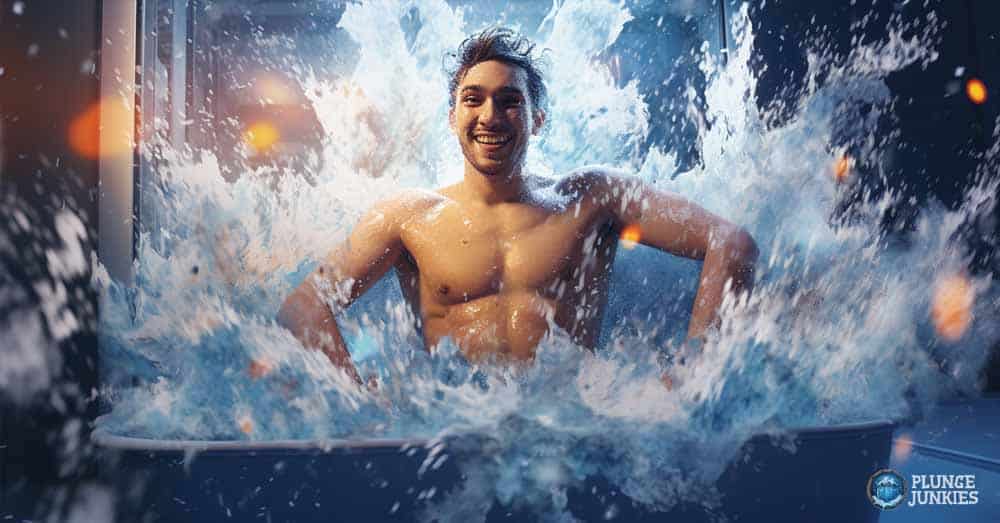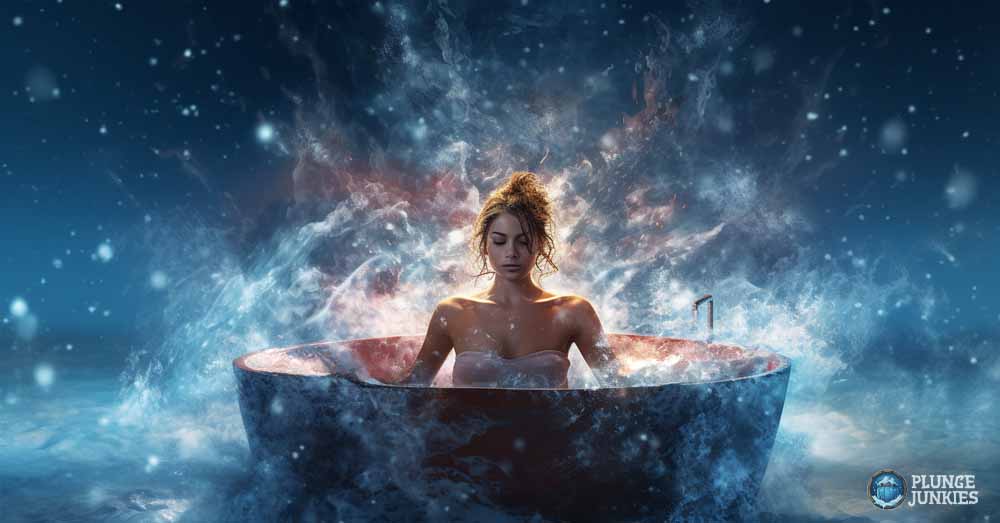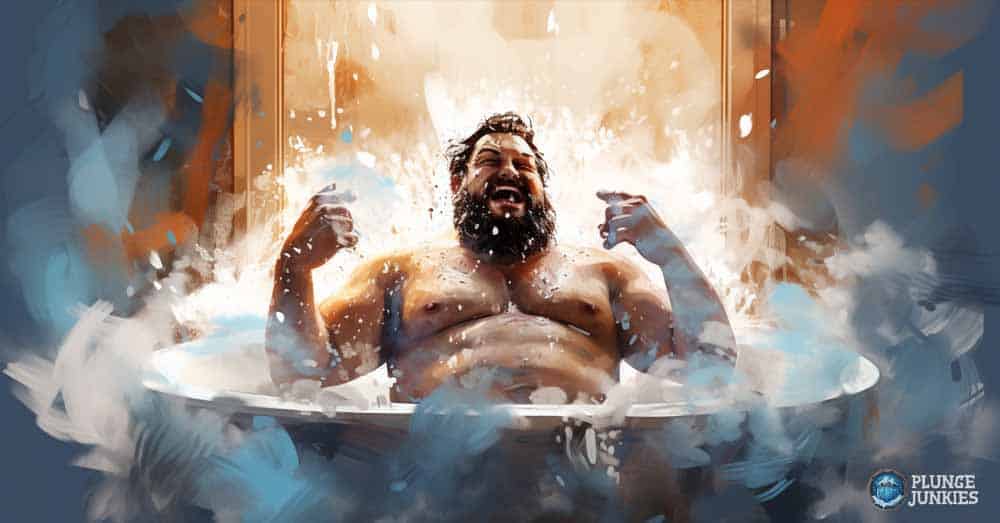Ice baths and cold plunges might just be your secret weapon in unlocking a treasure trove of holistic wellness.
While the thought of submerging yourself into a tub filled with icy cold water may send shivers down your spine, research reveals proven ways icy dips can improve your mind and body.
This in-depth guide provides a closer look at 15 scientifically-proven ice bath benefits, from igniting your metabolism and reducing inflammation to enhancing your mental fortitude and even potentially prolonging your life.
In a world where rapid technological advancements often push us towards seeking quick, artificial solutions to bettering our health, plunging into the crisp, natural embrace of cold water emerges as a compelling, ancient method of healing and empowerment.
Whether you’re an athlete, biohacker, or simply curious about cold therapy and cold plunge tubs, read on to uncover the fascinating physiological effects that make ice bath benefits well worth the chill.
What Are the Benefits of Taking Ice Baths?
Here’s a deeper look at 15 science-backed benefits you may gain from taking an ice bath.
1. Increases Metabolism & Burns Fat
Plunging into an ice bath can shock your body into burning more calories. The extreme cold triggers your stores of brown fat, also known as brown adipose tissue (BAT), to release energy and generate heat in a process called non-shivering thermogenesis.
Multiple studies on both mice and humans have shown that cold exposure from ice baths activates BAT, temporarily boosting metabolic rate during the exposure. The colder the water, the greater the metabolic stimulation.
A 2000 human study [1] immersed young adult men in cold water up to their necks for one hour. Metabolic rate increased compared to baseline:
| 89°F (32°C) water | No increase |
| 68°F (20°C) water | 93% increase |
| 57°F (14°C) water | 350% increase |
Another 2014 study [2] found that exposing mice to 4°C (39°F) air 3 times per week doubled their metabolic rates during the cold exposure due to brown fat activation.

Beyond the immediate boost, frequent cold plunges may also build up your overall reserves of BAT over time. The more brown fat you have, the more calories you can burn when exposed to cold.
In addition to BAT activation, shivering from ice baths further elevates metabolism. As your muscles rapidly contract from the cold, your body has to expend extra energy and calories to generate heat.
While shivering provides a short-term metabolism increase, BAT activation seems to have a greater, more sustained impact on calorie expenditure.
The bottom line is that routine ice baths may support subtle fat loss over time by repeatedly boosting your metabolic rate and increasing your calorie-burning brown fat stores. Just a few minutes of teeth-chattering cold can stoke your body’s inner furnace.
There are several other mechanisms by which ice baths and cold plunges can aid in fat loss including:
- Releasing fat-burning hormones such as dopamine and norepinephrine
- Reducing stress hormones like cortisol
- Improving insulin sensitivity
For a deeper dive—including how to optimize your ice bath for fat loss—be sure to check out our comprehensive and science-packed article “7 Ways Ice Baths Burn Fat.”

2. Reduces Inflammation & Pain
Cold plunges can provide natural pain and inflammation relief. The extreme cold causes blood vessels near the skin’s surface to abruptly constrict, reducing local swelling and limiting the movement of inflammatory molecules.
This vascular response directly lowers inflammation in affected areas. The rapid constriction also increases overall circulation, flushing metabolic waste from the body.
Recent studies show cold exposure activates brown adipose tissue (BAT), a unique fat that generates heat. Active BAT releases a substance called maresin 2 that calms inflammatory immune cells called macrophages.
By suppressing these drivers of systemic inflammation, maresin 2 provides whole-body anti-inflammatory effects.

A 2022 analysis [3] of regular winter swimmers found lower oxidative stress and more antioxidants compared to non-swimmers, indicating reduced inflammation from repeated cold immersion.
Another 2022 [4] study showed mice exposed to cold had decreased inflammation and better blood sugar regulation due to maresin 2 production.
In essence, an ice bath cools local swelling while also triggering helpful body-wide responses that resolve inflammation. This one-two punch of reducing local and systemic inflammation can provide natural pain relief while improving overall health.
3. Fights Anxiety, Stress, & Depression
The physiological effects of ice baths can significantly reduce feelings of anxiety, stress, and depression. Cold water immersion triggers vasoconstriction, causing blood vessels to narrow before dilating and increasing circulation.
This delivers more oxygen and nutrients throughout the body, enhancing overall function and potentially lowering blood pressure, a key contributor to anxiety.
Additionally, ice baths prompt the release of endorphins, the body’s natural feel-good chemicals. Endorphins bind to receptors in the brain, blocking the perception of pain and generating a sense of euphoria and relaxation.
This natural endorphin high can alleviate symptoms of depression and calm anxious thoughts.

Ice baths have also been shown to decrease levels of the stress hormone cortisol, which is closely linked to anxiety and the body’s “fight or flight” response. Lowering cortisol brings the body out of this tense, worried state.
The intense cold can also serve as a distracting stimulus that forces one to focus fully on the present moment. This mindfulness halts the tendency to ruminate on anxious thoughts and worries.
One well-referenced study [5] found that immersion in 57°F water increased levels of noradrenaline by 530% and dopamine by 250%, chemicals that boost mood, motivation, and alertness. By influencing numerous physiological and neurological processes, ice baths can profoundly reduce feelings of stress and instill deep tranquility.
But this is only the tip of the iceberg (pun intended)! For a full look into the many benefits of ice baths and cold plunges on mental health check out “How Ice Baths Improve Your Mental Health.”
4. Boosts Willpower, Motivation, & Innovation
The shock of an icy plunge electrifies both body and mind, stimulating a cascade of hormones and neurotransmitters that amplify motivation, sharpen cognition, and spur creativity.
As the freezing water hits the skin, the sympathetic nervous system initiates an energizing fight-or-flight response. Noradrenaline surges through the body, elevating mood, intensifying alertness, and inducing a potent focus ideal for driving willpower.
This biochemical boost provides the mental fuel to push harder and charge after goals with tenacious determination.
Endorphins also flood the system, eliciting a euphoric rush that further amplifies motivation. Where once a challenge seemed insurmountable, in this biologically-primed state obstacles appear less daunting.

Mental fortitude and grit also strengthen with each teeth-chattering dip as one summons the inner resolve to withstand the intense cold. Tolerating such extreme physiological stress requires deep reserves of willpower and mental stamina.
Like lifting weights builds muscle, facing the icy plunge hardens the muscle of the mind. A sense of achievement compounds this effect; conquering the cold imbues an empowering confidence to persevere in the face of adversity.
The heightened arousal and alertness elicited by the cold may also prime the mind for imaginative insights. Endorphins and dopamine enhance creative drive and flow, while the stimulation unlocks more flexible cognitive patterns. In this state of intense focus yet unbounded awareness, unique associations and ideas can emerge.
A 2023 study [6] found short cold immersion increased positive emotions like feeling active, proud, and inspired, linked to enhanced brain connectivity in areas regulating attention, emotion, and self-control.
5. Ice Cold Emotional Resilience
The extreme cold of an ice bath provides intense mental training for developing emotional resilience. Facing the shocking plunge requires practicing techniques like stress reframing and mindfulness to endure the discomfort.
Gradually acclimating to the cold acts as stress inoculation, enabling better coping when real crises strike. The cold shock prompts the release of anti-inflammatory proteins and hormones (cytokines and catecholamines) to restrict blood flow and flush systemic inflammation.
This parasympathetic regulation and anti-inflammatory response teach physiological self-soothing skills. Plunging into near-freezing water also elevates mood-boosting dopamine and endorphins, promoting neurochemical resilience.

With each teeth-chattering dip, the prefrontal cortex—the brain region that controls executive function and emotional regulation—is also conditioned to regulate amygdala reactivity. The amygdala is the part of the brain responsible for emotional processing and fear responses. This enhances the mind’s ability to handle stress and bounce back from challenges.
Overall, the voluntary self-inflicted stress of icy immersion serves to inoculate against involuntary future stresses—steeping the mind like a forged sword to yield an inner core of ironclad resilience.
6. Benefits Skin & Hair Health
Plunging into an ice bath can send shivers down your spine, but your skin and hair reap the refreshing benefits.
During cold exposure, blood vessels constrict to prevent heat loss (called vasoconstriction). This rush calms inflammatory conditions like acne, eczema, and sunburns by reducing redness, irritation, and swelling.
The chilled temperature also causes pores and fine lines to temporarily tighten, making your complexion look firmer and smoother. When you emerge from the icy dip, blood circulation rebounds as vessels dilate again, circulating oxygen and nutrients for a healthy glow.
Cold stress even promotes collagen production by lowering stress hormones, increasing elasticity, and reducing wrinkles. Additionally, the brisk chill prevents pore-clogging sebum oil production to deter acne.

Your hair enjoys the frigid water too, sealing the cuticle, and locking in moisture for enhanced shine, strength, and hydration. This sealing also prevents split ends and breakage.
As your scalp’s blood vessels contract and dilate, circulation improves to nourish follicles. Scalp oil production is balanced to avoid greasy hair and dandruff. Lastly, the tightened cuticle adds volume and fullness.
However, excessive ice bathing can potentially damage skin and hair over time, so moderation is key.
7. Supports Sleep & Recovery
Taking an ice bath a few hours before bedtime could be an effective, natural way to get better sleep by triggering several beneficial bodily responses that scientific research has linked to improved sleep quality.
Since body temperature naturally decreases at night to initiate sleep, lowering it ahead of time via an ice bath mimics and works with this natural process.
Additionally, brief exposure to cold has been shown to increase circulating levels of the hormone melatonin in the blood. Melatonin is intricately involved in regulating sleep-wake cycles.

A 2018 study [7] discovered that cold winter temperatures dramatically increased melatonin concentration in animals compared to warmer weather, providing an increase in melatonin levels within 90 minutes following cold exposure.
The stimulating effect of cold may also positively influence mood by increasing dopamine and serotonin levels in the brain. Better mood and relaxation before sleep leads to reduced sleep latency and higher quality sleep, according to psychologists.
In light of the evidence on melatonin release, body temperature regulation, and mood improvements, taking an ice bath a few hours before bedtime seems to be an effective way to enhance sleep quality through natural mechanisms.
Taking an ice bath 1-2 hours before bed may allow time for the alertness boost to fade before sleep.
8. Improves Circulation
Ice baths can provide dozens of health benefits by improving circulation and cardiovascular health.
When you first enter an ice bath, your blood vessels constrict, or narrow, to prevent heat loss. This reduces blood flow to your muscles and other tissues.
However, your body cannot maintain this constricted state for long, so your blood vessels eventually dilate, or widen. This rapid constriction and dilation of the blood vessels provides a type of pump action that enhances circulation.

In addition, ice baths can help to improve circulation by increasing the production of nitric oxide. Nitric oxide is a molecule that helps to widen blood vessels by relaxing blood vessel walls.
Improved circulation caused by ice baths can have a number of benefits, including reduced risk of heart conditions, obesity, and blood clots.
The increased blood flow can also aid in the delivery of nutrients and oxygen to muscles and other tissues, which may help speed up the recovery process following intense exercise or injury.
9. Faster Muscle Recovery
Taking an ice bath after intense exercise provides several advantages that accelerate the muscle recovery process for both men and women.
The chilly water causes blood vessels to constrict, reducing inflammation that contributes to post-workout muscle soreness.
Ice baths also help flush out lactic acid and metabolic waste that accumulate in muscles during strenuous activity.
A study in 2021 [8] demonstrated that cold water immersion therapy led to notable improvements in agility, speed, power, balance, and sport-specific skills such as dribbling and kicking in college athletes.
Cold exposure helped decrease muscle fatigue and inflammation, enabling quicker reinstatement of optimal physical performance.

Another research trial [9] found cold water immersion post-training reduced biomarkers of muscle damage like creatine kinase, lactate dehydrogenase, aspartate aminotransferase, and alanine aminotransferase.
It also:
- Lowered perceived muscle soreness versus passive recovery
- Boosted recovery of muscle power
- Decreased damage from intense exercise
Overall, a cold plunge can help any athlete return to peak condition faster after grueling workouts.
10. Increased Immunity
Ice baths can boost immunity and reduce sickness by activating certain immune cells and antibodies.
Cold exposure triggers a brief fight-or-flight response, releasing hormones like noradrenaline that stimulate disease-fighting white blood cells when the immune system needs it most.
Enhanced circulation from cold may also distribute more oxygen, nutrients, and immune cells to infected areas.

Cold plunges can relieve congestion and stuffiness from colds or flu by constricting blood vessels in the nasal passages and sinuses, reducing swelling and fluid build-up. This opens nasal airways and sinuses, allowing better drainage and cleared breathing.
Cold exposure can also lower fever by constricting blood vessels and shedding excess heat.
However, prolonged chilling strains the body, so caution is warranted for those with medical conditions like heart disease or respiratory infections.
11. Boosts Testosterone in Men
Studies show that cold water immersion from ice baths can increase testosterone levels and improve male health in several ways.
First, research indicates that regular ice baths increase red blood cell production and hemoglobin levels [10]. This enhances the body’s oxygen-carrying capacity, which can indirectly boost testosterone as better oxygenation stimulates testosterone-producing Leydig cells.
Second, cooling the scrotum to 95-98°F helps sperm and testosterone production. A 2013 study [11] found sperm quality improved in winter’s cooler temperatures versus summer.

Research on monkeys showed heat exposure lowered testosterone [12]. So keeping the testicles cooler aids healthy testosterone levels.
Finally, cold exposure spikes luteinizing hormone (LH), which signals the testes to produce more testosterone. A 1991 study [13] on men found that cold exposure before exercise significantly increased LH levels by over 20%.
Although testosterone initially drops after cold exposure, the sustained high LH causes testosterone to rebound even higher than baseline.
For men struggling with low testosterone, seeking performance benefits, or wishing to proactively support testosterone levels, ice baths, and cold plunges may provide a simple, accessible way to harness the body’s natural hormonal response to cold.
12. Increased Fertility
Ice baths may provide fertility benefits for both men and women by optimizing temperatures for reproductive health.
For men, brief cold water immersion may optimize testicular temperature to enhance sperm production and quality. The testes require a slightly cooler temperature than the body’s core to synthesize healthy sperm.
A 2013 study [11] found men had higher sperm quality in colder winter months, suggesting cooler temperatures correlate with better sperm health. Another study in 1987 [14] determined the optimal temperature for testicular function is 31-37°C.

In women, preliminary research indicates cold therapy can improve menstrual regularity, ovulation, and hormone balance.
A study [15] exposed rats with polycystic ovarian syndrome (PCOS)—a common hormone disorder causing fertility issues—to daily cold water therapy. The cold-treated PCOS rats showed more regular cycles, lower androgen levels, increased ovulation, and improved fertility rates compared to untreated rats.
Scientists propose the benefits may be due to cold improving insulin sensitivity, fat metabolism, and reproductive hormone balance.
However, more studies are needed to confirm if ice baths provide similar ovulation and fertility benefits in women with PCOS or related disorders.
13. Helps Insulin Resistance
Taking an ice bath can help regulate blood sugar levels and reduce the risk of diabetes.
The human body requires the hormone insulin to properly control blood sugar levels. Insulin is created by the pancreas and enables glucose (sugar) in the bloodstream to move into the body’s cells, where glucose can be broken down and utilized for energy.
However, in some cases, the body’s cells can develop a decreased sensitivity or even resistance to the effects of insulin.
This condition, known as insulin resistance, makes it challenging for the body to appropriately process sugars and can lead to high blood sugar levels. If left unchecked, is a primary contributing factor in the eventual onset of type 2 diabetes.

Fortunately, studies have demonstrated that cold water immersion may help combat insulin resistance and improve blood sugar regulation.
This effect is tied to cold stimulation of brown adipose tissue (brown fat). Brown fat is a unique type of body fat that is densely packed with mitochondria and blood vessels.
When the body is exposed to cold temperatures, brown fat generates heat by ramping up the breakdown of glucose and fatty acids within its cells. This process essentially burns through blood glucose while activating brown fat to produce warmth that maintains a healthy body temperature.
One trial [16] had diabetics take 10 days of 60°F baths. The cold water activated their brown fat, improving insulin sensitivity by 43%. Additional research confirms cold exposure’s benefits.
While more research is needed, ice baths show promise as an accessible strategy to stabilize blood sugar and reduce diabetes risk.
14. Supports Lymphatic System
Cold plunges can also improve lymphatic circulation throughout the body. The lymphatic system is like a secondary circulatory system that carries lymph fluid containing white blood cells and removes waste.
When exposed to cold water, the lymph vessels constrict, forcing this fluid to flow faster throughout the system.
This helps fight infections by circulating more lymphocytes, maintains fluid balance by improving drainage, and reduces swelling by constricting vessels.

Studies [17] have shown that cold water can significantly increase lymph flow-–regardless of whether pressure is added or not. Water at 1 °C (34 °F) had the most significant effect.
Those with health conditions involving inflammation or fluid retention may benefit from cold water plunging because of this impact on lymph circulation and vessel constriction.
15. Improves Aging And Increases Lifespan
Routine ice baths may help slow the aging process and extend lifespan, according to emerging research.
The proposed mechanism is that the cold temperature stresses cells in a beneficial way. Specifically, it causes mild oxidative stress that stimulates your cells to produce more antioxidants, which protect against damage.

One study [18] found cold air exposure shielded skin cells from UV damage and reduced wrinkle formation.
The cold also enhances mitochondrial health—mitochondria are the “engines” in your cells that produce energy. Better mitochondrial function is tied to more youthful skin cells.
Additionally, cold exposure triggers a hormetic response—this is when temporary stress makes cells adapt by boosting their defenses and repair abilities. Hormesis leads to overall improved cellular health and resilience.
In essence, the periodic stress of an ice bath puts your cells through a training regimen that keeps them stronger and more vibrant as you get older.
Are Ice Baths Dangerous?
Though cold water immersion can provide benefits, it also carries risks that require caution.
- Hypothermia: Immersing oneself in icy waters can lead to hypothermia, a condition where the body loses heat faster than it can produce. Hypothermia can cause shivering, dizziness, confusion, and at extreme, life-threatening situations if the core body temperature drops drastically.
- Cold Shock Response: The sudden plunge into cold water can trigger a cold shock response, characterized by an involuntary gasping reflex, increased heart rate, and a spike in blood pressure. This sudden cardiovascular change can be risky for individuals with underlying heart conditions.
- Muscle Cramping and Decreased Strength: Cold temperatures can affect muscle contraction, leading to muscle cramping and a temporary reduction in strength. This can be particularly hazardous if one is alone or in deep water, as the decreased mobility may pose a danger.
- Skin and Hair Irritation: Frequent cold water immersion can strip away the skin and hair’s natural oils, causing dryness, irritation, and brittleness, which may lead to discomfort or dermatological issues over time.
- Overstimulation of the Sympathetic Nervous System: The body’s reaction to cold can overstimulate the sympathetic nervous system, disrupting the normal stress response. This could potentially cause or exacerbate anxiety and stress-related conditions.
- Increased Risk of Infection: The reduced blood circulation to the skin may impair the immune response, potentially increasing the susceptibility to skin infections, especially in communal bathing environments.
- Potential Risks to Pregnant Women: Cold water immersion can cause blood vessel constriction, possibly leading to dizziness or other circulatory issues in pregnant women. It’s vital to consult with healthcare professionals before engaging in cold water immersion during pregnancy.
- Risk of Slips and Falls: The shock of cold, coupled with wet and slippery surfaces, can increase the risk of losing balance and falling, which could lead to injuries ranging from minor to severe.
Gradual exposure, limiting time in cold water, avoiding extreme temperatures if you have pre-existing conditions, and listening to your body’s signals can help reduce these dangers. Consulting a doctor is wise to ensure cold plunges are safe for you.
Also, be sure to read our comprehensive guide, “Are Ice Baths Dangerous,” for an incredibly deep look into the risks associated with cold exposure therapy.
Who Should Avoid an Ice Bath?
Cold exposure can have a number of health benefits, but it is important to be aware of the risks before trying it.
Some people should avoid cold exposure altogether, including people with heart conditions, people with respiratory conditions, people with circulatory problems, people with neurological conditions, and pregnant women.
If you are unsure whether cold exposure is safe for you, talk to your doctor first.
Ice Bath vs Cold Shower

Cold water therapy, whether in the form of cold showers or ice baths, both provide benefits. However, there are key factors to consider when choosing between taking a brisk cold shower or submerging your body in an ice bath.
Here’s an in-depth look at the key differences.
- Temperature: The most obvious difference lies in the temperature of the water. Cold showers typically involve water in the 50-60°F range. An ice bath temperature on the other hand consists of much colder water, usually between 35-55°F, since it is filled with ice or held at cold temperatures with a water chiller. Those extra 10-15 degrees make a big impact in terms of the body’s physiological reaction.
- Intensity: The colder temperature of an ice bath leads to more intense responses in the body like constriction of blood vessels and activation of brown fat. This leads to a spike in metabolic rate and potentially greater benefits. However, the extreme cold can be difficult to handle for beginners.
- Ease of Access: One major advantage of cold showers is they can be done daily at home with no special equipment. Ice baths require obtaining large amounts of ice as well as either having access to a bathtub or purchasing a specialized cold plunge tub. This may limit ice baths to only occasional use.
- Discomfort and Risk: It’s no secret that ice baths will be tremendously uncomfortable, especially at first. They may also carry a slightly higher risk if you stay submerged too long. Cold showers tend to be more tolerable while still providing benefits.
- Full Body Exposure: When it comes to reducing inflammation and enhancing vagus nerve stimulation, full submersion of your entire body into an ice bath may have added advantages over a cold shower.
While ice baths tend to provide greater benefits thanks to colder temperatures and full body exposure, they require more costs and preparation which can limit the frequency of use. Cold showers are more accessible and still provide advantages, just on a smaller scale.
For most beginners, starting with cold showers to build tolerance and working your way toward sporadic ice baths as feasible is recommended.
For a deeper dive into the differences between these two types of cold exposure, check out our article on ice baths vs cold showers.
Closing Thoughts
The science is clear that ice baths and cold water immersion provide a wide array of evidence-based health and performance benefits. From accelerating workout recovery to reducing inflammation, boosting metabolism, and improving mental resilience, the physiological effects of brief cold exposure are profound.
While plunging into icy water can be intensely uncomfortable at first, gradually acclimating and limiting time to a few minutes can make the experience tolerable and maximize advantages while minimizing risks. Start with cold showers if needed, then work up towards occasional ice baths for amplified effects.
Always check with your doctor before trying extreme cold exposure if you have any medical conditions. And be sure to listen to your body’s signals—get out if you feel any chest tightness or pain. With reasonable precautions, an ice bath routine may be one of the most potent biohacks you can add to your wellness toolkit.
The next time you’re looking to take your health, mindset, or fitness to the next level, consider facing your fears and taking the plunge into an ice-cold, invigorating embrace brimming with benefits. Just be ready for some teeth-chattering!
We can help you here at Plunge Junkies! What ever questions you have about getting started with cold water therapy we can answer or point you in the right direction.
References
- Kowaltowski, Alicia J. “Cold Exposure and the Metabolism of Mice, Men, and Other Wonderful Creatures.” Physiology (Bethesda, Md.) vol. 37,5 (2022): 0. doi:10.1152/physiol.00002.2022
- Šrámek, P., Šimečková, M., Janský, L. et al. Human physiological responses to immersion into water of different temperatures. Eur J Appl Physiol 81, 436–442 (2000). https://doi.org/10.1007/s004210050065
- Esperland D, de Weerd L, Mercer JB. Health effects of voluntary exposure to cold water – a continuing subject of debate. Int J Circumpolar Health. 2022 Dec;81(1):2111789. doi: 10.1080/22423982.2022.2111789. PMID: 36137565; PMCID: PMC9518606.
- Sugimoto, Satoru et al. “Brown adipose tissue-derived MaR2 contributes to cold-induced resolution of inflammation.” Nature metabolism vol. 4,6 (2022): 775-790. doi:10.1038/s42255-022-00590-0
- Srámek P, Simecková M, Janský L, Savlíková J, Vybíral S. Human physiological responses to immersion into water of different temperatures. Eur J Appl Physiol. 2000 Mar;81(5):436-42. doi: 10.1007/s004210050065. PMID: 10751106.
- Yankouskaya, Ala et al. “Short-Term Head-Out Whole-Body Cold-Water Immersion Facilitates Positive Affect and Increases Interaction between Large-Scale Brain Networks.” Biology vol. 12,2 211. 29 Jan. 2023, doi:10.3390/biology12020211
- Xu, Xiaoying et al. “Association of Melatonin Production with Seasonal Changes, Low Temperature, and Immuno-Responses in Hamsters.” Molecules (Basel, Switzerland) vol. 23,3 703. 20 Mar. 2018, doi:10.3390/molecules23030703
- Lee, Yoon-Hyung et al. “Effects of Cool-Down Exercise and Cold-Water Immersion Therapy on Basic Fitness and Sport-Specific Skills among Korean College Soccer Players.” Iranian journal of public health vol. 50,11 (2021): 2211-2218. doi:10.18502/ijph.v50i11.7575
- Fonseca, Líllian Beatriz et al. “Use of Cold-Water Immersion to Reduce Muscle Damage and Delayed-Onset Muscle Soreness and Preserve Muscle Power in Jiu-Jitsu Athletes.” Journal of athletic training vol. 51,7 (2016): 540-9. doi:10.4085/1062-6050-51.9.01
- Checinska-Maciejewska Z, Niepolski L, Checinska A, Korek E, Kolodziejczak B, Kopczynski Z, Krauss H, Pruszynska-Oszmalek E, Kolodziejski P, Gibas-Dorna M. Regular cold water swimming during winter time affects resting hematological parameters and serum erythropoietin. J Physiol Pharmacol. 2019 Oct;70(5). doi: 10.26402/jpp.2019.5.10. Epub 2020 Jan 30. PMID: 32009627.
- Levitas E, Lunenfeld E, Weisz N, Friger M, Har-Vardi I. Seasonal variations of human sperm cells among 6455 semen samples: a plausible explanation of a seasonal birth pattern. American Journal of Obstetrics & Gynecology. 2013;208(5):406.E1-406.E6. doi:10.1016/j.ajog.2013.02.010.
- Lue YH, Lasley BL, Laughlin LS, Swerdloff RS, Hikim AP, Leung A, Overstreet JW, Wang C. Mild testicular hyperthermia induces profound transitional spermatogenic suppression through increased germ cell apoptosis in adult cynomolgus monkeys (Macaca fascicularis). J Androl. 2002 Nov-Dec;23(6):799-805. PMID: 12399525.
- Sakamoto, K., Wakabayashi, I., Yoshimoto, S., Masui, H., & Katsuno, S. (1991). Effects of physical exercise and cold stimulation on serum testosterone level in men. Japanese Journal of Hygiene, 46(2).
- Nakamura M, Namiki M, Okuyama A, Koh E, Kondoh N, Takeyama M. Optimal Temperature for Synthesis of DNA, RNA, and Protein by Human Testis in Vitro. Archives of Andrology. 1988;20(1):41-44.
- Ye R, Yan C, Zhou H, Huang Y, Dong M, Zhang H, Jiang X, Yuan S, Chen L, Jiang R, Cheng Z, Zheng K, Zhang Q, Jin W. Brown Adipose Tissue Activation by Cold Treatment Ameliorates Polycystic Ovary Syndrome in Rat. Front Endocrinol (Lausanne). 2021 Oct 14;12:744628. doi: 10.3389/fendo.2021.744628. PMID: 34721298; PMCID: PMC8552032.
- Hanssen, Mark J W et al. “Short-term cold acclimation improves insulin sensitivity in patients with type 2 diabetes mellitus.” Nature medicine vol. 21,8 (2015): 863-5. doi:10.1038/nm.3891
- Meeusen R, van der Veen P, Joos E, Roeykens J, Bossuyt A, De Meirleir K. The influence of cold and compression on lymph flow at the ankle. Clin J Sport Med. 1998 Oct;8(4):266-71. doi: 10.1097/00042752-199810000-00003. PMID: 9884790.
- Bujarrabal, Arturo, and Björn Schumacher. “Hormesis running hot and cold.” Cell cycle (Georgetown, Tex.) vol. 15,24 (2016): 3335-3336. doi:10.1080/15384101.2016.1235859





















